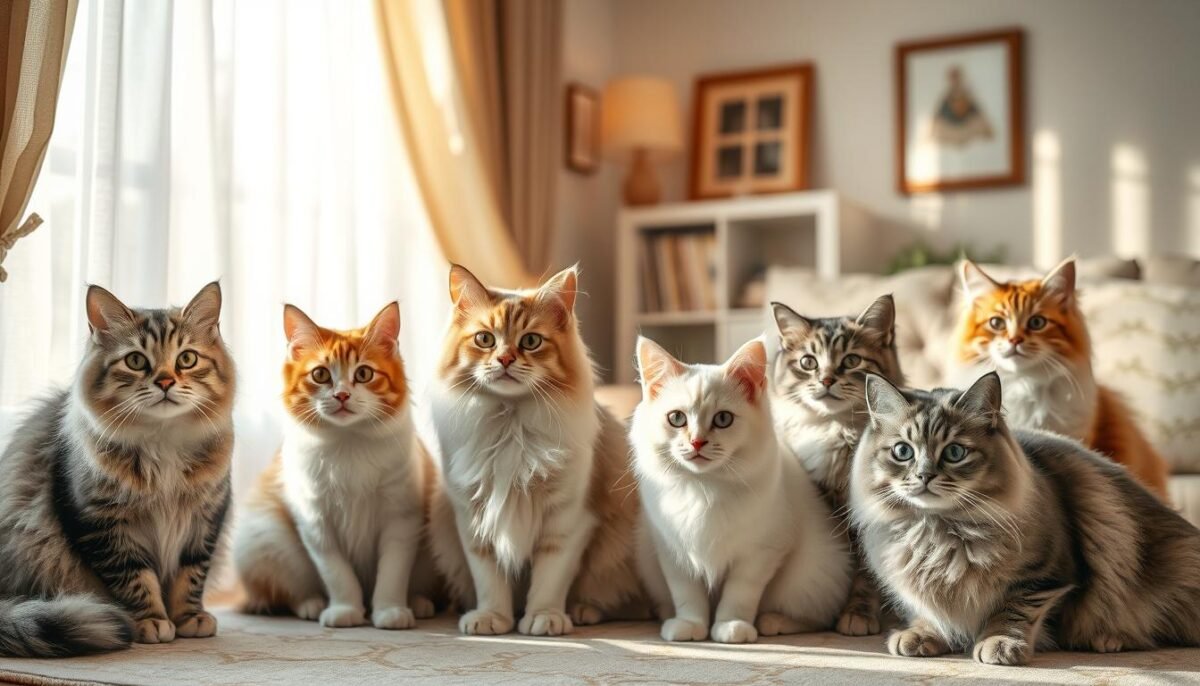Are you an allergy sufferer who’s dreamed of owning a furry feline companion? Look no further! We’re here to help you discover the joys of adopting a hypoallergenic cat. These cats are perfect for people with pet allergies. They let you experience the unconditional love and companionship of a cat without the sniffles and sneezes.
In this comprehensive guide, we’ll explore the world of hypoallergenic cats. We’ll uncover what makes these special breeds so well-suited for allergy-prone individuals. From understanding the science behind their hypoallergenic nature to identifying the most popular hypoallergenic cat breeds, we’ll equip you with the knowledge to find your perfect match.
Key Takeaways
- Hypoallergenic cats produce lower levels of the protein that triggers allergic reactions in humans.
- Several breeds, such as Siberian and Balinese cats, are known for their hypoallergenic qualities.
- Adopting a hypoallergenic cat can provide a rewarding experience for allergy sufferers.
- Understanding the adoption process and preparing your home can help ensure a successful transition for your new feline friend.
- Proper care and grooming can help minimize allergens and keep your hypoallergenic cat healthy and happy.
So, are you ready to discover the perfect hypoallergenic cat for your home? Let’s dive in and explore the world of low-allergen felines waiting to find their forever families.
Understanding Hypoallergenic Cats
Hypoallergenic cats are popular among people with allergies. But what makes them special? These cats have traits that lower the chance of causing allergic reactions.
What Makes a Cat Hypoallergenic?
The main allergen in cat allergies is not their fur. It’s proteins in their saliva, skin, and urine. Hypoallergenic cats make less of these proteins. Or their proteins are less likely to cause allergies.
Common Breeds of Hypoallergenic Cats
- Siberian cats: Known for their low-shedding, hypoallergenic coats.
- Balinese cats: A long-haired breed with a reduced production of the Fel d 1 protein, the main cat allergen.
- Cornish Rex: This breed has a unique, curly coat that sheds less than traditional cat fur.
- Sphynx cats: With their hairless appearance, Sphynx cats produce significantly less dander and allergens.
Myths About Hypoallergenic Cats
There are myths about hypoallergenic cats. No cat is 100% hypoallergenic. But some breeds are less likely to cause allergies.
“The term ‘hypoallergenic’ simply means that a cat produces fewer allergens, not that it is entirely allergen-free.”
Also, how someone reacts to a cat can vary. Keeping your home clean and grooming your cat well helps manage allergies, no matter the breed.
Benefits of Adopting a Hypoallergenic Cat
Choosing a hypoallergenic cat can bring joy to those who have struggled with allergies. These cats are bred to have lower allergens. They make great pets for those who want a furry friend without health worries.
Health and Allergy Considerations
Hypoallergenic cats make less of the Fel d 1 protein, the main allergen. This means people with cat allergies can live well with these cats. They can enjoy a cat’s company without sneezing, itching, and other symptoms.
Getting a hypoallergenic kitten can change lives. It’s a chance for those who wanted a pet but were held back by allergies.
Companionship and Emotional Support
Hypoallergenic cats offer more than health benefits. They provide emotional support and companionship. Their gentle nature and low-shedding coats make them perfect for those seeking love and stress relief.
Exploring hypoallergenic cats can lead to a life filled with joy and comfort. With the right care, these cats can improve your well-being and make your life richer.
How to Identify Hypoallergenic Cats
Looking for a cat that’s easy on allergy sufferers? It’s key to know what makes hypoallergenic cat breeds special. These cats often have unique looks that help them produce less dander. Knowing these traits can help you pick the right cat for your home.
Recognizing Low-Allergen Breeds
One big sign of a hypoallergenic cat is its fur. Cats like the Siberian, Balinese, and Javanese have short, single-layer fur that sheds less. Also, hairless cat breeds, like the Sphynx, are great for people with allergies because they produce very little allergen.
Tips for Allergy Sufferers
- Get to know a cat before adopting to see how you react to it.
- Think about the grooming needs of a cat and make sure you can handle them.
- Keep your home clean and well-ventilated to cut down on allergens.
By learning about hypoallergenic cat breeds and keeping your home clean, you can have a cat without worrying about allergies. With the right research and care, you can find a non-shedding or hairless cat to be your friend.
Where to Find Hypoallergenic Cats for Adoption
If you have allergies and want a cat, there are many places to find hypoallergenic ones. You can look at local shelters, breed-specific rescues, or online platforms. Each option offers a chance to find your new hypoallergenic cat.
Local Animal Shelters and Rescue Organizations
Start by visiting your local animal shelters and rescue groups. They have many cat breeds, including hypoallergenic ones, waiting for homes. Contacting them can help you find out about available cats and hypoallergenic breeds.
Online Adoption Platforms
The internet is also a great place to find hypoallergenic cats. Sites like Petfinder and Adopt-a-Pet list cats from all over, including hypoallergenic ones. You can filter by breed, size, and age to find the right cat for you.
Finding a hypoallergenic cat might seem hard, but it’s doable. Look at local shelters, breed-specific rescues, and online platforms. With some effort, you can bring home an allergy-friendly cat.
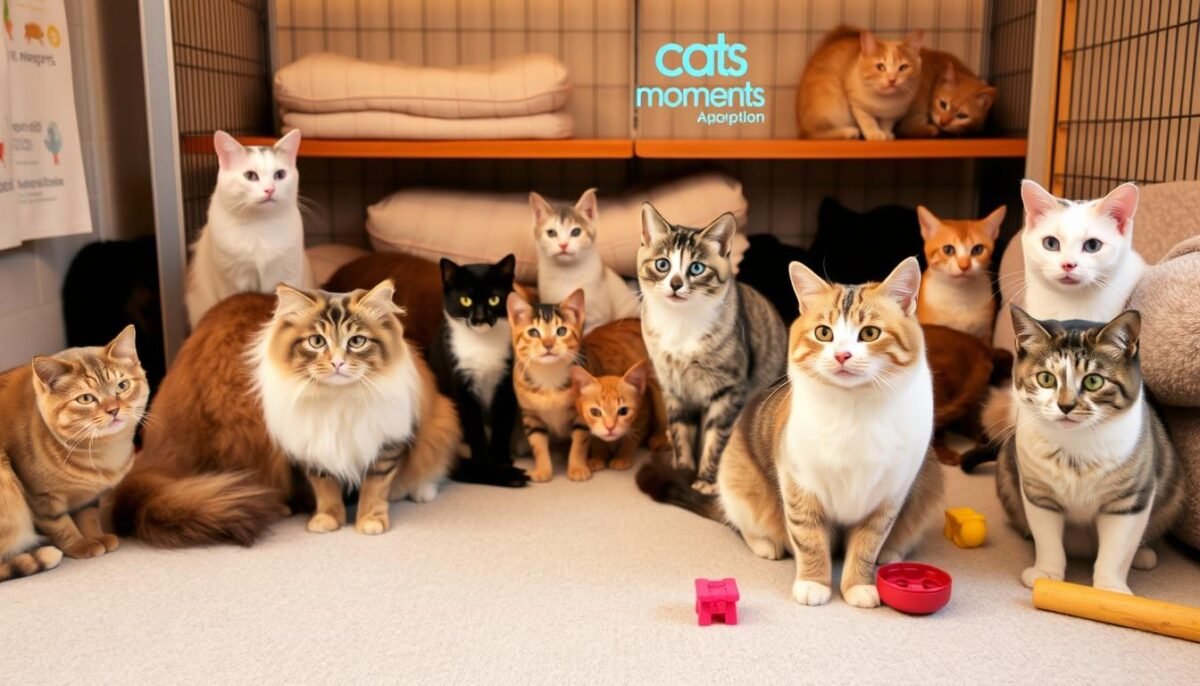
Preparing Your Home for a Hypoallergenic Cat
Getting ready for a hypoallergenic cat means making your home safe and cozy. We aim for allergy-free cat ownership. Here are some tips to cut down on allergens and keep your home healthy for you and your cat.
Creating a Safe and Comfortable Environment
To get your home ready for a hypoallergenic cat, look for potential dangers. Make sure houseplants and decorations are safe for cats. Give your cat lots of places to climb and sit, as they like being up high. Also, pick furniture and fabrics that are simple to clean and don’t hold onto cat hair.
Cleaning and Maintenance Tips
- Vacuum often with a HEPA filter to catch cat dander and hair.
- Wipe surfaces with a damp cloth to trap allergens.
- Regular grooming helps remove extra fur and lessens shedding.
- Use air purifiers and filters to keep the air clean.
- Choose furniture that’s easy to clean, like leather or vinyl.
By following these cleaning and upkeep tips, you can make a comfy, allergy-free space for you and your hypoallergenic cat. A bit of work will help you enjoy your cat’s company without allergies getting in the way.
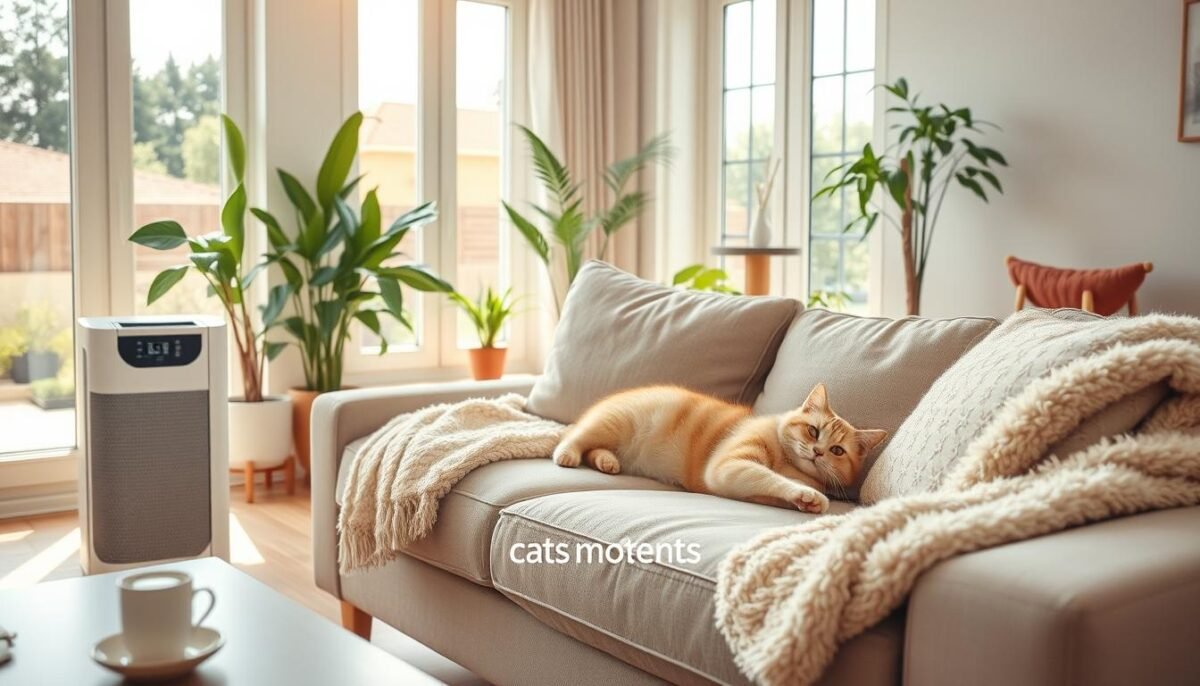
The Adoption Process Explained
Adopting a hypoallergenic cat is rewarding but requires understanding the process. Whether you seek hypoallergenic kittens available or cats for allergy sufferers, several steps are involved.
What to Expect During the Adoption
Ready to welcome a new cat? The adoption starts with an application. Shelters or rescue groups will ask about your home, pet experience, and ability to care for a cat. This ensures a perfect match for you and the cat.
Essential Questions to Ask the Shelter
Before adopting, ask the right questions. This helps you make a smart choice. Key questions include:
- The cat’s medical history and any special needs
- The cat’s temperament and any behavioral concerns
- The cat’s grooming requirements and shedding levels
- The shelter’s policies on returns or adoptions failing to work out
- The support the shelter offers to new adoptive families
These questions help you prepare for your cat’s needs. This way, you can give your new pet the best care.
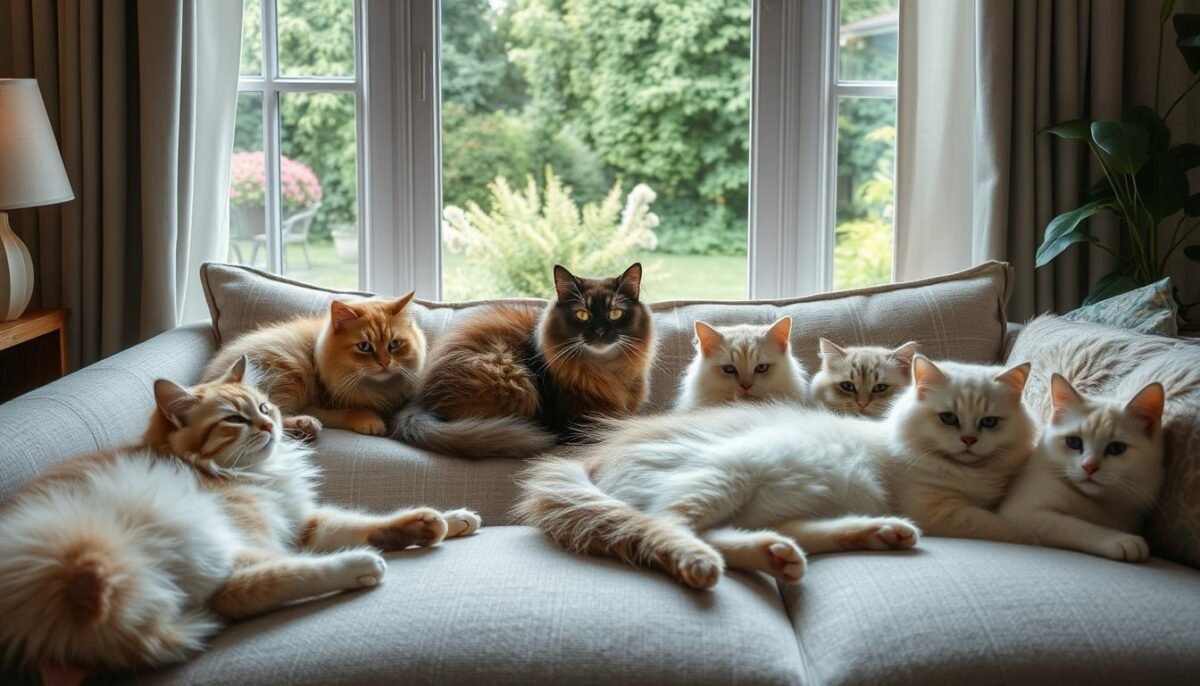
Adopting a hypoallergenic cat is a big step. But with care and diligence, it can be life-changing. By understanding the process and asking the right questions, you can give your new pet a loving home.
Caring for Your Hypoallergenic Cat
Getting a hypoallergenic cat can change your life if you have allergies. But, you need to know how to take care of these special cats. We’ll show you how to keep your hypoallergenic cat healthy and happy.
Grooming Tips for Reducing Allergens
Regular grooming is crucial to cut down on dander and hair that can cause allergies. Brush your hypoallergenic cat every week with a slicker brush or deshedding tool. This helps remove loose fur and spreads natural oils in their coat.
Bathing should be rare, as it can take away the cat’s protective oils. Use a gentle, hypoallergenic shampoo to lessen allergens further.
Nutrition and Health Needs
Hypoallergenic cat breeds, like Siberians and Balinese, need special food to keep their coats and health up. Choose high-quality, protein-rich cat food made for low-shedding cats. Adding omega-3 and omega-6 fatty acids to their diet can also help.
These nutrients reduce skin irritation and make their coat shiny and healthy. Regular vet visits are also key to keeping your hypoallergenic cat in great shape.
By following these grooming and nutrition tips, you can lower allergens and keep your hypoallergenic cat happy and healthy. With a bit of extra care, you can enjoy the company of these low-shedding cats without worrying about allergies.
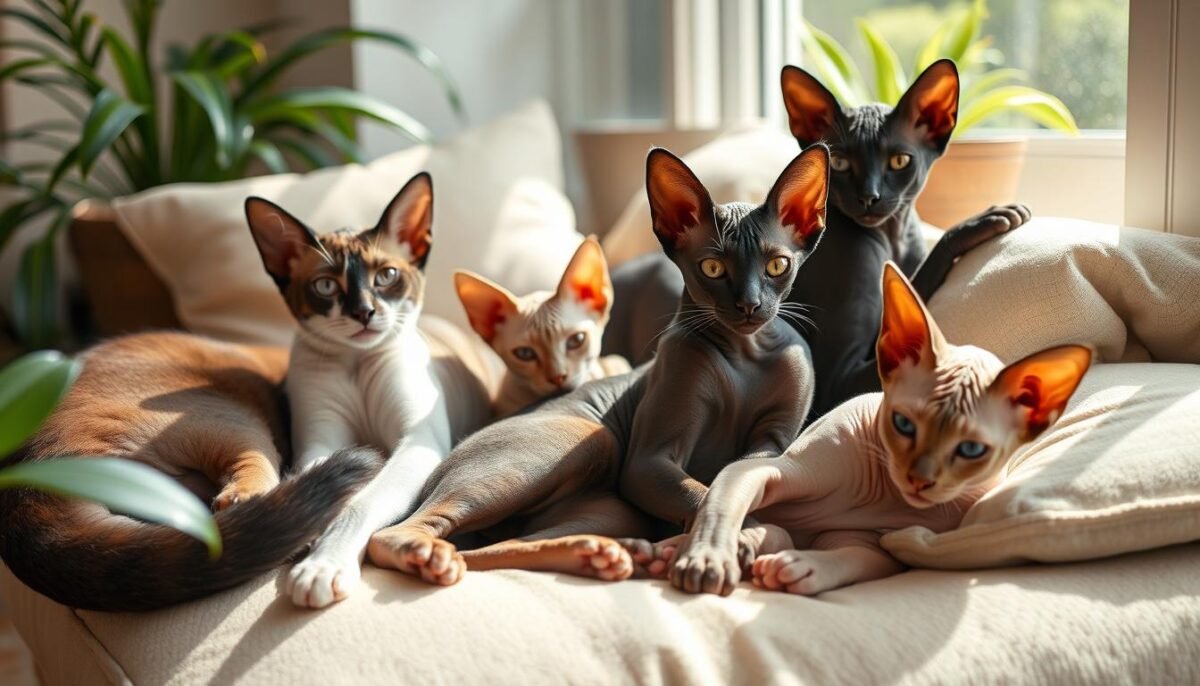
Training Your Hypoallergenic Cat
Owning a hypoallergenic cat is a joy. But, training and socializing them is key for a happy home. We’ll cover the best ways to train your hypoallergenic cat.
Basic Training Techniques
Positive reinforcement works great for hypoallergenic cats like Siberians and Balinese. Start with simple commands like “sit,” “stay,” and “come.” Give treats or praise when they get it right. Remember, training takes time and effort.
Teaching your cat to use the litter box is important. Place it in a quiet spot and praise them when they use it. Clean up accidents well to stop them from happening again.
Socialization Strategies
Socializing your cat is crucial for their happiness and yours. Introduce them to new people and places slowly and positively. Reward them for being calm and confident. This makes them feel safe and happy.
Think about enrolling your cat in a socialization class or getting help from a certified animal behaviorist. They can give you tailored advice and techniques for a friendly cat.
With patience, consistency, and positive reinforcement, you can train and socialize your hypoallergenic cat. This way, you’ll have a happy and harmonious life together.
Understanding Cat Allergies
Having a cat can be a joy, but for those with allergies, it’s a different story. Knowing the signs and what causes cat allergies is key. It helps make a safe space for you and your pet.
Symptoms and Triggers
Common allergy symptoms include sneezing, itchy eyes, and skin issues. These problems usually come from proteins in a cat’s dander, saliva, and urine. Even cats thought to be hypoallergenic can still cause allergies in some people.
Strategies for Managing Allergies at Home
- Use high-efficiency particulate air (HEPA) filters to remove airborne allergens from your home.
- Regularly groom your cat and bathe them using a gentle, hypoallergenic shampoo to minimize dander buildup.
- Vacuum frequently, focusing on areas where your cat spends the most time, to remove pet hair and dander.
- Consider using allergen-reducing products, such as specialized cat litter or furniture covers, to create a more allergy-friendly environment.
- Limit your cat’s access to certain rooms, such as the bedroom, to reduce your exposure to allergens.
By knowing the signs and causes of cat allergies and using these tips, people with allergies can still have a pet. They can enjoy the company of cats while keeping their home safe from allergens.
“With the right precautions and a little creativity, those with cat allergies can still find joy in owning a feline companion.”
Success Stories: Hypoallergenic Cats
Exploring the world of hypoallergenic cats, we find joy and companionship for those with allergies. Our research into Specialty Purebred Cat Rescue’s adoption success shows heartwarming tales. These stories are of people finding their perfect furry friends, despite allergies.
Inspiring Adoption Stories
Emily, a cat lover, had always wanted a pet but was held back by allergies. She found a Siberian cat through a local rescue. Emily welcomed the cat, and to her surprise, her allergies didn’t flare up much.
The bond between Emily and her cat grew stronger every day. She was amazed by how the Siberian cat’s coat made pet ownership possible for her.
Testimonials from Allergy Sufferers
For many with allergies, owning a cat seemed impossible. But hypoallergenic cat breeds have changed that. Jessica, who has allergies, adopted a Balinese cat.
“I never thought I’d have a cat,” Jessica said. “But the Balinese’s coat and grooming needs let me enjoy a cat’s company without allergies. It’s changed my life, and I’m thankful for this breed.”
FAQ
What makes a cat hypoallergenic?
Hypoallergenic cats make less of the protein in their dander and saliva that causes allergies. Breeds like Siberian and Balinese cats have traits that lower these allergens.
What are some common breeds of hypoallergenic cats?
Popular hypoallergenic cat breeds include Sphynx, Siberian, Balinese, Javanese, and Cornish Rex. These cats shed less and make fewer allergy-causing proteins.
Are there any myths about hypoallergenic cats?
Yes, a common myth is that hypoallergenic cats don’t shed or cause allergies at all. While they make fewer allergens, they can still cause reactions. Regular grooming and cleaning are key to reducing allergens at home.
What are the health and allergy benefits of adopting a hypoallergenic cat?
Hypoallergenic cats can greatly benefit people with allergies. They are less likely to trigger allergic symptoms. This makes it possible for those who couldn’t have cats before to have one. They also offer emotional support and companionship.
How can I identify a hypoallergenic cat breed?
Look for physical traits like a short, sleek coat or no fur to identify hypoallergenic cat breeds. Breeds like Sphynx and Cornish Rex have unique coats that produce fewer allergens. Consider their shedding and grooming needs too.
Where can I find hypoallergenic cats for adoption?
You can find hypoallergenic cats for adoption at local shelters, breed-specific rescue groups, and online platforms. These resources help you find kittens or adult cats in your area.
How do I prepare my home for a hypoallergenic cat?
To make your home safe for a hypoallergenic cat, set up a cat-friendly area. Regular cleaning and using air purifiers or allergen-reducing products are also important.
What should I expect during the hypoallergenic cat adoption process?
Expect a thorough screening when adopting a hypoallergenic cat. Shelters or rescue groups will check if the cat fits your lifestyle and allergies. Be ready to ask about the cat’s health, behavior, and care needs.
How do I care for a hypoallergenic cat?
Caring for a hypoallergenic cat means regular grooming to reduce allergens. Brush and bathe them often. Also, focus on their nutrition and health, and keep your home clean for both your comfort and theirs.
How can I train and socialize a hypoallergenic cat?
Training and socializing a hypoallergenic cat is similar to other breeds. Use positive reinforcement and introduce them to new people and places slowly. This helps them feel comfortable and confident.
How can I effectively manage cat allergies at home?
Manage cat allergies at home with air purifiers, regular vacuuming, and cleaning. Groom your hypoallergenic cat often and keep your home clean. Talk to your healthcare provider for more ways to reduce allergy symptoms.
